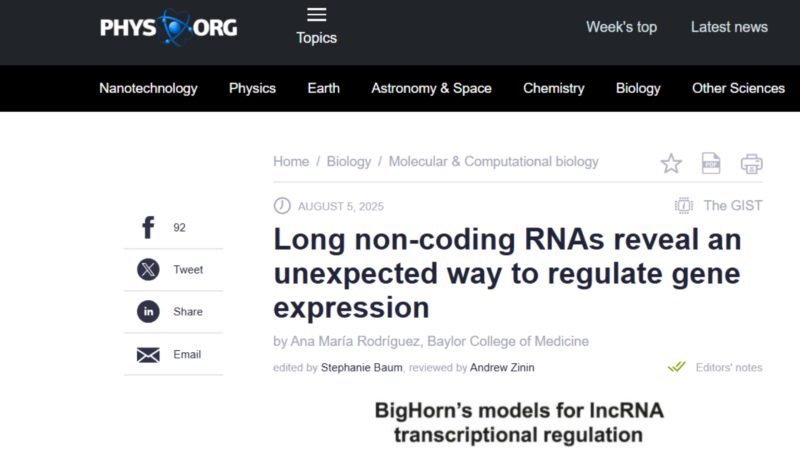
E. Shyam P. Reddy: A New Phenomenon the Researchers Call Coordinated Regulation
E. Shyam P. Reddy, Professor and Director of Cancer Biology Program at Morehouse School of Medicine, shared a post on LinkedIn:
“Long non-coding RNAs (lncRNA) are a type of RNA molecule that do not carry instructions to make proteins. Instead, they influence how other genes are expressed. There are tens of thousands of lncRNAs in the human body, many of which are active in specific tissues or diseases like cancer. However, figuring out exactly what they do has been a major challenge.
Led by Baylor College of Medicine first authors Drs. Hua-Sheng Chiu and Sonal Somvanshi, researchers at Baylor, Ghent University in Belgium, Tsinghua University in China and other collaborating institutions worked together to better understand how lncRNAs function. Their findings revealed that lncRNAs seem to regulate gene expression in a coordinated manner that had not been seen before.
Their study is the cover story of this month’s issue of Cell Genomics.
Long non-coding RNAs have been involved in many key cell processes, including cell and tissue development. They may bind DNA regions to regulate gene transcription into RNA or regulate post-transcriptional events—the processing of these RNAs by altering their stability, degradation and translation into proteins.
“Despite their abundance and their association with specific diseases, only the functions of a few lncRNAs have been fully characterized,” said lead corresponding author Dr. Pavel Sumazin, associate professor of pediatrics and member of the Jan and Dan Comprehensive Cancer Center at Baylor. He is also the director of the Bioinformatics Core Laboratory at Texas Children’s Hospital. “However, these studies have often been unable to provide mechanistic insights into lncRNA function.”
The team began by developing a powerful new computational tool called BigHorn that uses machine learning to predict where lncRNAs bind to DNA and which genes they regulate. Unlike older methods that rely on stringent sequence matching, BigHorn looks for more flexible “elastic” patterns in the DNA that better reflect how lncRNAs behave in living cells.
“We tested BigHorn on data from more than 27,000 samples, including many types of cancer,” said Chiu, assistant professor of pediatrics—oncology at Baylor and Texas Children’s Hospital. “We found that it significantly outperformed previous tools in predicting lncRNA–DNA interactions.”
Interestingly, BigHorn accurately identified cases where a single lncRNA regulates a gene at both the transcriptional and post-transcriptional levels—a new phenomenon the researchers call coordinated regulation.
“These lncRNAs may act as molecular chaperones that control the stability and translation of mRNAs they helped transcribe, leading to tightly coupled expression profiles,” said Chiu.
To demonstrate how powerful this approach can be, the team focused on one lncRNA called ZFAS1. This molecule is often found in high levels in cancer cells and was predicted by BigHorn to regulate many important genes.
One of the key targets of ZFAS1 is DICER1, a cancer gene that plays a central role in producing.”
Title: Long non-coding RNAs reveal an unexpected way to regulate gene expression
Authors: Ana María Rodríguez
Read the Full Article.

More posts featuring E. Shyam P. Reddy.
-
Challenging the Status Quo in Colorectal Cancer 2024
December 6-8, 2024
-
ESMO 2024 Congress
September 13-17, 2024
-
ASCO Annual Meeting
May 30 - June 4, 2024
-
Yvonne Award 2024
May 31, 2024
-
OncoThon 2024, Online
Feb. 15, 2024
-
Global Summit on War & Cancer 2023, Online
Dec. 14-16, 2023
